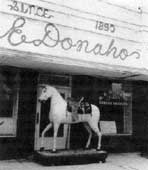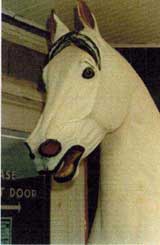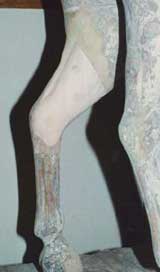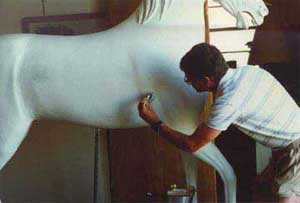Restorations
|
As we age, certain memories sharpen and others fade. For each of us there is a special event, special place or a special toy that stands out more than others. For my mother, this favorite memory was watching parades atop a grand steed in front of my grandfather's saddle shop in San Angelo, Texas. The horse in my mother's memories was a larger than life, dapple gray known in San Angelo as Confederate Gray. Confederate Gray was a fixture outside the saddle shop hen my grandfather purchased the shop in 1890. No one seemed to know where the horse had come from or who made the horse. The horse was the meeting place for Confederate war veterans for many years. The stories this horse must have heard! |
Alan Carr on Confederate
Gray, circa 1949 |
|
 |
 |
|
 Confederate Gray, Circa 1925 |
In 1936, my grandmother donated the horse to the Fort Concho museum. Confederate Gray was brought back out for various community parades and events. Over the years, he fell into disrepair. He had been painted and crudely doctored. His ears were broken, seams had opened along his sides, and his legs were in major need of repair. He was no longer strong enough to strut down Main Street. As the years passed, Confederate Gray found himself relegated to an old mule shed. In 1996, I found myself facing a familiar dilemma - what to do for a gift? This time, the gift was for my mother's 90th birthday. I had been creating new horses for three years - of course, I could tackle a restoration project. | |
|
The Fort Concho museum gave me permission to bring Confederate Gray to Fredericksburg for a restoration. Little did I know what I would find. My sister and I have heard story after story about Confederate Gray. In mother's stories, he was always a dapple gray. In my memories, he was always white. Three layers of lead-based paint were removed to reveal an off-white horse dappled with gray. I sent a sample of the wood off to the Texas Forest Products lab. It turns out the horse was made from magnolia - definitely not a "native" tree in dry San Angelo in the 1870's. Nine months later, Confederate Gray was ready for his return trip to San Angelo. There was no way to predict his reception. My mother was thrilled - I had managed to keep it a surprise. But what I was surprised at was the number of "old-timers" who came out for his return. He not only belonged to my family, but he belonged to the community as well. I got to see a little bit of the young girl my mother once was - and to see the same special look in many faces as they reached to touch the old steed.
|
 |
 |
 |
 |
|
 |
Confederate
Gray currently resides at the Fort Concho
museum. The "gratis" restoration had taken 37
weeks (over 250 man-hours) to complete. I have
since been approached by several owners of
genuine antique "rocking" gliders and will take
on restorations as time permits. I try to
preserve as much of the original horse as
possible and only replace what is necessary to
make it safe. Your particular rocking horse may have seen some hard times and abuse, but if the sentimental value exceeds the monetary worth ... it deserves a new lease on life! Send pictures of both sides and close-ups of the problem areas. I can most times return a "ball park" quote for restoration from the pictures and may be able to ascertain who the original maker was. All restorations are a labor of love, so give me time to carefully rebuild and restore what is necessary to make the horse safe for many generations of adoring children to enjoy. |
|
